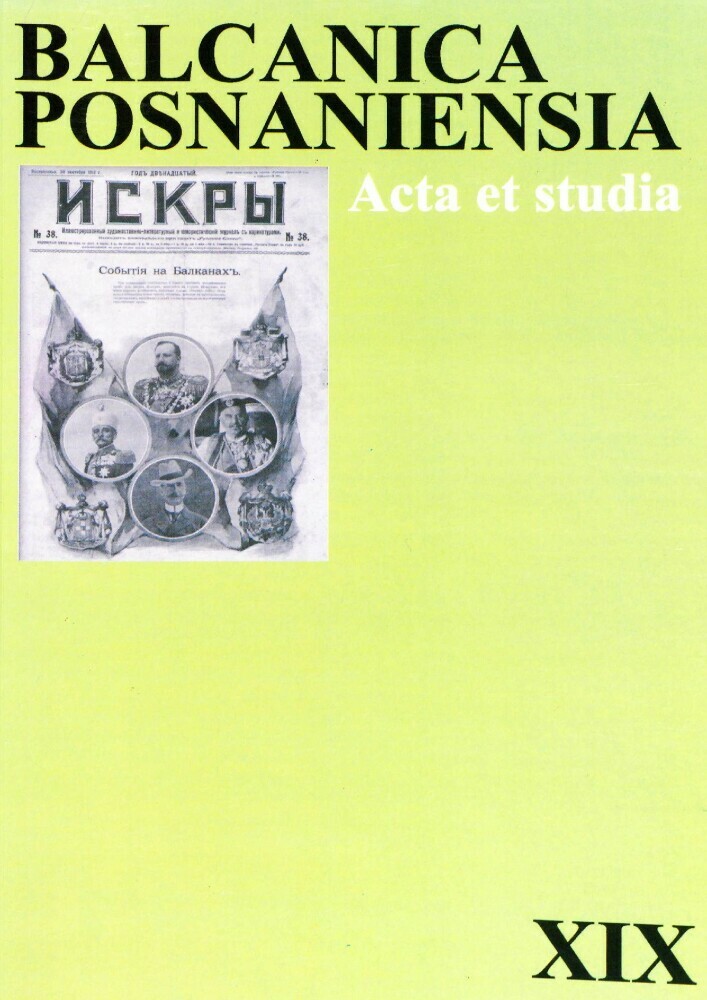Abstract
The Medieval Balkans are characterized by three basic imperial archetypes – Byzantine ecumenism and the imperial ideas of Bulgarians and Serbs. The Byzantine political doctrine based upon the idea that the empire is called upon to impose the Christian religion over the barbarian worlds was transformed throughout the period of the Balkan Revival into the so-called „Megali idea” and found its reflection in the political goals of the Greek Kingdom during the Balkan Wars. The Bulgarian Medieval archetype, expressed in Simeon’s idea of a Bulgarian-Byzantine empire with Constantinople as its capital and in the concept that took shape in the ХІІІ-th century of „Tarnovo – the Third Rome”, gave Paisii Hilendarski grounds to provoke the national self-conscience. The apogee of Renaissance aspirations, San Stefano Bulgaria, was not realized but it gave birth to the myth of „Bulgaria bordering three seas”, which pushed Bulgaria into the wars as a road to national union. The third „player” on the Balkan scene – the Kingdom of Serbia in its turn sought its grounds in Stefan Dushan’s empire and its Renaissance version – the „ Načertanije” of Ilija Garašanin. Thus, the Balkan union, created in the name of a noble and just cause – to liberate their Christian „brothers” from the oppression of the Ottoman Islamic Empire, turned out in its very bud to be on mined land by these projects imperial in their nature.License
- The Author hereby warrants that he/she is the owner of all the copyright and other intellectual property rights in the Work and that, within the scope of the present Agreement, the paper does not infringe the legal rights of another person.The owner of the copyright work also warrants that he/she is the sole and original creator thereof and that is not bound by any legal constraints in regard to the use or sale of the work.
- The Author grants the Purchaser non-exclusive and free of charge license to unlimited use worldwide over an unspecified period of time in the following areas of exploitation:
2.1. production of multiple copies of the Work produced according to the specific application of a given technology, including printing, reproduction of graphics through mechanical or electrical means (reprography) and digital technology;
2.2. marketing authorisation, loan or lease of the original or copies thereof;
2.3. public performance, public performance in the broadcast, video screening, media enhancements as well as broadcasting and rebroadcasting, made available to the public in such a way that members of the public may access the Work from a place and at a time individually chosen by them;
2.4. inclusion of the Work into a collective work (i.e. with a number of contributions);
2.5. inclusion of the Work in the electronic version to be offered on an electronic platform, or any other conceivable introduction of the Work in its electronic version to the Internet;
2.6. dissemination of electronic versions of the Work in its electronic version online, in a collective work or independently;
2.7. making the Work in the electronic version available to the public in such a way that members of the public may access the Work from a place and at a time individually chosen by them, in particular by making it accessible via the Internet, Intranet, Extranet;
2.8. making the Work available according to appropriate license pattern Attribution-NoDerivatives 4.0 International (CC BY-ND 4.0) as well as another language version of this license or any later version published by Creative Commons. - The Author grants the Adam Mickiewicz University in Poznan permission to:
3.1. reproduce a single copy (print or download) and royalty-free use and disposal of rights to compilations of the Work and these compilations.
3.2. send metadata files related to the Work, including to commercial and non-commercial journal-indexing databases. - The Author declares that, on the basis of the license granted in the present Agreement, the Purchaser is entitled and obliged to allow third parties to obtain further licenses (sublicenses) to the Work and to other materials, including derivatives thereof or compilations made based on or including the Work, whereas the provisions of such sub-licenses will be the same as with the attributed license pattern Attribution-NoDerivatives 4.0 International (CC BY-ND 4.0) or another language version of this license, or any later version of this license published by Creative Commons. Thereby, the Author entitles all interested parties to use the work, for non-commercial purposes only, under the following conditions:
4.1. acknowledgment of authorship, i.e. observing the obligation to provide, along with the distributed work, information about the author, title, source (link to the original Work, DOI) and of the license itself.
4.2. the derivatives of the Work are subject to the same conditions, i.e. they may be published only based on a licence which would be identical to the one granting access to the original Work. - The University of Adam Mickiewicz in Poznań is obliged to
5.1. make the Work available to the public in such a way that members of the public may access the Work from a place and at a time individually chosen by them, without any technological constraints;
5.2. appropriately inform members of the public to whom the Work is to be made available about sublicenses in such a way as to ensure that all parties are properly informed (appropriate informing messages).
Other provisions
- The University of Adam Mickiewicz in Poznań hereby preserves the copyright to the journal as a whole (layout/stylesheet, graphics, cover design, logo etc.)

